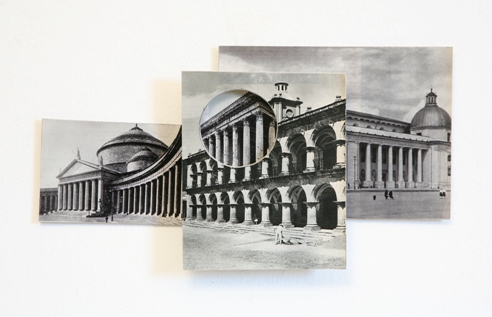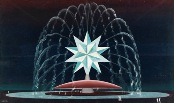
Lorenzo Missoni, L'enciclopedia, 2012, Courtesy dell’artista.
MART
There and Again. Souvenir de Voyage
Mart Rovereto 22nd June – 8th September 2013
Press conference Friday 21st June at 11.30 am
Inauguration
Friday 21st June at 7 pm
“There is only one voyage possible: the one we undertake within our inner world (…) We take everything we are with us on our travels”
Andrei Tarkosvsky
The Mart presents “There and again. Souvenir de voyage”, providing a link between the tourist’s eyes and the space of tourism in an exhibition open from 22nd June to 8th September 2013. Photographs taken during 19th-century Grand Tours, early 20th-century guidebooks for travellers, travel diaries, a series of advertisements ranging from artistic illustration to kitsch, the irony of Pop Art, the contemporary languages of video and installation. These are just some of the surprises in store in an exhibition the seeks to understand how the way we travel has changed, together with how we see the places visited under the impetus of globalisation and the mass post-modern world. “There and again”, has been produced by the Mart di Rovereto and curated by Nicoletta Boschiero, Veronica Caciolli, Daniela Ferrari, Paola Pettenella, Alessandra Tiddia and Denis Viva. The exhibition catalogue includes a text by Fernando Castro Florez.
The exhibition opens with “A voyage in time”, a story through images of the great Russian director, Andrei Tarkovsky, who undertook his own Grand Tour in 1983 in the company of poet and screenwriter, Tonino Guerra. Their way of travelling yielded nothing to the temptations of memory, but gathered images to appropriate themselves and the world.
“Photographing”, stated Susan Sontag, “means appropriating the thing you are photographing. It means establishing a special relationship with the world that gives a sensation of knowledge and thus of power”.
The tale of this voyage introduces the key theme of the exhibition in a critical manner: the global mass tourism industry today inundates us with images of places with a “tourist slant”. These are “images of images” which go to feed our mental maps and condition our image of the world in a precise way: that of the progressive superimposition of tourist and cultural spaces. The construction of spaces destined to host the “tourist experience” (theme parks, shopping centres) is evolving in an innovative fashion that mirrors the cultural evolution under way in contemporary society. The post-modern tourist space, in other words, is characterised by an extreme fragmentation of the signs ordering it. Souvenirs are the gifts we bring home from holidays, something conventional and banal, but we cannot help ourselves. Art too is a gift that lies between insignificance and sublimation, the result of a voyage or of a process, the traces of which have since been erased.
THE EXHIBITION
The “There and again” exhibition leads the visitor through time and space, to real, imagined and imaginary places: videos, installations, paintings, sculptures by contemporary artists and four magical chambres, in which to relive moments and accounts of journeys through documents, photographs and archive material.In the first chambre, visitors will re-experience the Grand Tour, the educative voyage undertaken by young European aristocrats, especially from the 18th century onwards. On display are admirable optical views, the stereoscopes of cities and landscapes, the first travel guides and the “souvenir” albums from the beginning of the last century.
The second chambre illustrates the long cruises and passages by sea across the Mediterranean – as recorded in a variety of memoirs, diaries, photographs and personal anecdotes by intellectuals like Margherita Sarfatti and Gino Pollini – and across the ocean to America – as described in the papers of Fortunato Depero and Thayaht.
With the development of new means of transport, travelling changed identity. From a possibility reserved for a few well-heeled voyagers, travel became a tourist activity accessible to all. Logically, the third chambre presents the first advertising campaigns, the leaflets, posters and postcards – from the Wolfsoniana Collection of Genoa, from the Touring Club Italiano, the Museo degli usi e costumi della gente trentina, and the Museo della cartolina – which can be compared to today’s kitsch articles from souvenir stalls; these include boules à neige, objects and dishes which are all shown in the fourth chambre, in proof of an ever more widespread tourism, but one that is often superficial and inconsistent. The tourist industry is currently the world’s largest economic power house and is key to cultural processes and development. It is thanks to it that the diffuse ideology of globalisation is transmitted. While speaking of the theme of tourism, the exhibition also speaks of travel, the diaspora, but also of walking, the conversion of the world into a systematic non-place, the hybridisation of languages, pidgin talk.
The journey through contemporary art is a sort of simulacrum, the remains of a “nomadic” ideology that has also perhaps to do with a complete sedentary paralysis. From the 1960s, when Tano Festa introduced the images that have become icons of mass tourism into his work, such as Michelangelo according to Tano Festa (1967), to the new generations of artists in whom centuries of stratified visual culture transformed for the tourist’s use and consumption continue to emerge.
From this visual identity, formed of miniature Colosseums, panoramic binoculars, postcards with the most typical views of Venice, Rome or Florence, an artistic research has often developed that has sought to restore a sense of authenticity to these images, or to lay bare their abuse, their excess of visibility. This is a determining factor, above all for Italian art, as shown by the photographs of Luigi Ghirri, taken at the end of the 1970s in the L’Italia in miniatura park, which is in every sense an open-air souvenir, a place in which one can see all the iconic monuments beloved of Italy’s tourists in a fictional game of travel. But as the photographer states, it is so fake as to short-circuit back to the real experience of those locations lodged in our memories.
Alice Guareschi describes a journey that started off on the atlas and ended in the post-production of the filming done in four ‘coloured’ seas around the world (White, Red, Yellow and Black). The “sentimental” journey, an echo of Laurence Sterne, is represented by the feminine correspondence and self-portraits of Meri Gorni and by the outlines of some Mediterranean Isole (‘Islands’) drawn by Sabrina Mezzaqui.
Lorenzo Missoni’s collages, made by cutting out photographs from encyclopaedias, offer us an example of how common and overrated images can become the opportunity for a personal, imaginary voyage, drawing together places that are far apart and seen only in photographs. Maurizio Galimberti, instead, offers fresh views of more traditional Italian monuments transforming them in his Polaroid mosaics.
In his photographs, Davide Tranchina highlights the images that become stereotypes, thereby losing their originality and uniqueness. Petri Paselli creates a virtual voyage in Italy, photographing souvenirs within the settings in a home intended to show them off, thereby producing some curious short-circuits in meaning.
The artists also evoke the magical locations appearing in postcards, as in Aurora by Mario Airò and Souvenir San Gimignano by Vittorio Corsini, or mix tourist industry and film industry, as in the photographs of the sets for Hollywood blockbusters abandoned in the desert and revealed in the images of Rä di Martino, as though they were themselves, a simulation and surrogate, the true landscape and monument, thereby setting up an ambiguous game of allusions between cinema, cliche and reality.
The exhibition also presents a series of installations, devices alluding the tourists’ habits, such as the panoramic binoculars shown in Kaleidos by Maria Elisabetta Novello; or the rotating sunshades by Giulio Delvè, taken directly from the Hotel Tritone on Ischia in a sort of seaside memory inseparable from our holiday memories; and also the collage of maps of the Paris metro offered by Paola di Bello, which shows the most common tool enabling metropolitan tourists to find their way, but in gigantic and worn-out form.
The exhibition ends with the large installation called Per grazia ricevuta / per grazia riciclata by Julio Paz, displayed in the museum for the first time following its donation by the artist’s family. The Argentine artist, who died in 2010, gathered together a host of objects collected over the years between 1977 and 2008. These are ex votos, articles made using different materials to create a single huge fresco illustrating the artist’s nomadic life.
Artists on show
Mario AiròGiuseppe Armenia
Henri Béchard
Frères Bisson
Domenico Bresolin
Luca Campigotto
Giacomo Caneva
Martin Chambi
Giuseppe Cimetta
Vittorio Corsini
Louis De Clercq
Giulio Delvè
Paola Di Bello
Rä Di Martino
Benvenuto Disertori
Maxime Du Camp
Marcello Dudovich
Andrea Facco
Tano Festa
William Henry Fox Talbot
Francis Frith
Maurizio Galimberti
Luigi Ghirri
Meri Gorni
Alice Guareschi
Elisabeth Hölzl
Emilio Isgrò
Ketty La Rocca
Herbert List
Robert MacPherson
Hiroyuki Masuyama
Sabrina Mezzaqui
Lorenzo Missoni
Bruno Munari
Carlo Naya
Maria Elisabetta Novello
Julio Paz
Domenica Riccardo Peretti Griva
Antonio Fortunato Perini
PetriPaselli
James Robertson
Filippo Romoli
Sara Rossi
Alessandro Ruzzier
Francesco Satta
Carlo Baldassare Simelli
Florian Slotawa
Giorgio Sommer
Andrei Tarkovsky
Davide Tranchina
Patrick Tuttofuoco
Luca Vitone
C. & G. Zangaki
-
MART Contact
Responsabile Settore Comunicazione e Relazioni Esterne
Flavia Fossa Margutti
@flacarla
Press Office
press@mart.trento.it
@mart_museum
Luca Melchionna
T 0464 454127
M 320 4303487
M 338 6512683
@lmelk
Clementina Rizzi
T 0464 454124
@la_mentina
Carlotta Fanti
T 0464 454117


